
In a world overflowing with data, it’s easy to get lost in numbers and statistics. However, when you need to understand what your customers really think and feel, qualitative research is key.
For example, if you run a bakery, numbers can easily tell you what’s selling more, but they cannot tell you why. For that, you will need subjective questions that ask for details such as taste, preferences, quality, etc. Yes, those are qualitative questions!
In this blog, we’ll explore qualitative research methods, types, examples, and how to analyze them. Let’s dive in!
Watch: How to Measure Customer Satisfaction with ProProfs Survey Maker: Quick & Easy
What Is Qualitative Research?
Qualitative research is a branch of market research that involves collecting and analyzing qualitative data through open-ended communication. The primary purpose of conducting qualitative research is to understand an individual’s thoughts, feelings, opinions, and reasons behind these emotions.

The research gathers in-depth and rich insights into a particular topic. Understanding how your audience feels about a specific subject helps make informed decisions.
As opposed to quantitative research, qualitative research does not deal with the collection of numerical data for statistical analysis. The application of this research method is usually found in humanities and social science subjects like sociology, history, anthropology, health science, and education.
What Are the Types of Qualitative Research Methods?
Qualitative research methods include observations, one-on-one interviews, case study research, focus groups, ethnographic research, phenomenology, and grounded theory.
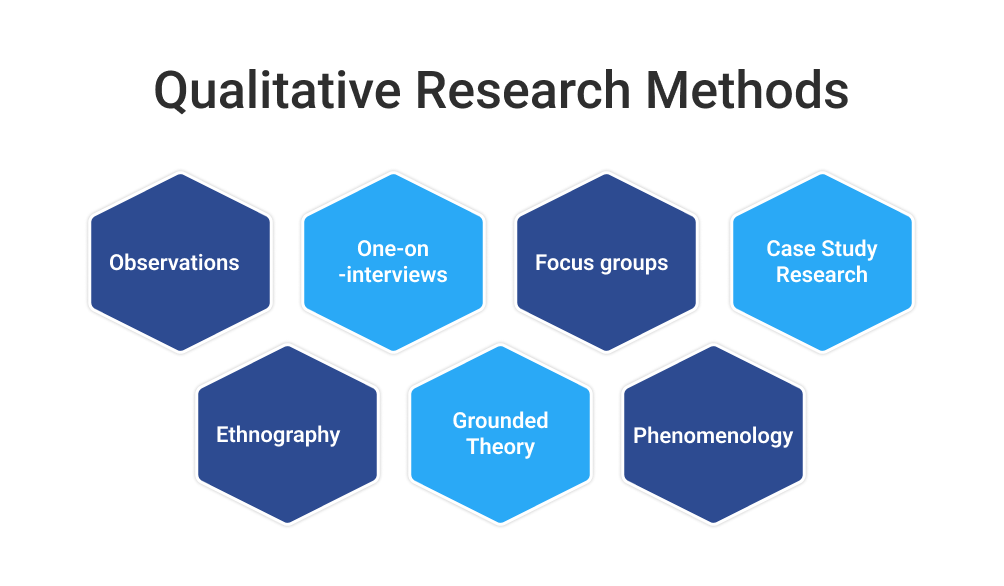
Let me elaborate.
1. Observations
Observation is one of the oldest and most fundamental methods in qualitative research, where the researcher immerses themselves in the natural environment of the subjects without intervening.
Observations are powerful because they capture behavior in its natural setting, giving you insights that a survey or interview might miss.
For example, while a customer might not openly admit to feeling uncomfortable with a store layout, their body language—like hesitating or avoiding certain areas—can speak volumes.
However, being an observer has its challenges. People might act differently if they know they’re being watched, and some nuances might be lost if you don’t know exactly what to look for. Despite this, observational research remains one of the most authentic ways to understand human behavior as it happens.
2. One-on-One Interviews
One-on-one interviews are a cornerstone of qualitative research, offering a direct channel for in-depth exploration of individual experiences, beliefs, and motivations.
Interviews can be –
- Structured interviews: These involve a predetermined set of questions asked in a standardized order.
- Semi-structured interviews: While there is a general guide, the interviewer has the flexibility to explore emerging themes.
- Unstructured interviews: These are conversational, with minimal guidance from the researcher.
One-on-one interviews are especially useful in healthcare settings. For instance, hospitals often conduct post-discharge interviews to understand how patients felt about their treatment journey, from admission to follow-up care.
These conversations reveal more than what a feedback form can capture: emotional pain points, communication gaps, or moments that made the patient feel genuinely cared for. Insights from such interviews help improve care quality, staff behavior, and patient trust.
3. Focus Groups
Focus groups involve discussions among a small group of participants, often managed by a moderator. These sessions are based on group interaction rather than individual responses. It’s not just about what each person thinks, but how their views evolve in conversation with others.
For example, one participant might praise your product’s design, prompting another to agree but mention improvements in functionality. These exchanges often reveal layered insights and perspectives you might miss in one-on-one formats.
In the education sector, universities use focus groups to evaluate online learning tools or new teaching methods. A group of students might discuss their experience with a hybrid course format, offering direct feedback that helps faculty refine future delivery.
Pro Tip: Whether live or digital, aim to create a space where everyone feels heard. Balance participation so dominant voices don’t overpower quieter ones.
4. Case Study Research
Case study research is an in-depth exploration of a specific case within its real-life context. They can focus on a single or multiple cases, providing a detailed and holistic understanding of the subject.
Think of it as telling a story, but with a purpose. For example, you might conduct a case study on a company that successfully turned around its customer satisfaction ratings.
Through detailed interviews, observations, and analysis, you uncover the strategies they used, the challenges they faced, and the outcomes they achieved.
For instance, an e-commerce business struggling with repeat customer complaints conducted a case study to explore the root cause. By interviewing customer support reps and analyzing transcripts from complaint calls, they found that unclear return policies were causing frustration.
As a result, they revamped their return flow and communication touchpoints. The case study helped the entire team, from marketing to logistics, understand the customer’s journey and align their solutions.
This in-depth exploration can provide valuable lessons and insights that are applicable to other situations.
5. Ethnography
Ethnography is a research method derived from anthropology, where the researcher immerses themselves in the culture or community they are studying, often for extended periods.
This immersion allows the researcher to gain a rich, holistic understanding of the community, far beyond what could be captured in a survey or interview.
However, since traditional ethnographic studies are extremely time-consuming, a better alternative is “digital ethnography.”
This method studies behavior, interactions, and social dynamics within online environments and digital communities.
In public health research, ethnography has been used to understand how rural communities in low-resource areas approach maternal healthcare.
Researchers live within the community, observe interactions with local health workers, and participate in daily routines to understand cultural barriers to care. These insights often influence how health campaigns are communicated and delivered.
In digital ethnography, the researcher acts as both an observer and a participant in these online communities to gain firsthand insight into the lifestyles, cultures, and traditions of people navigating these digital landscapes.
The studies are conducted remotely, reducing the need for extended physical presence in a specific location, and the data collection process is often more streamlined.
6. Grounded Theory
Grounded theory is a systematic methodology in qualitative research that generates theory through data collection and analysis. Unlike other research methods that start with a hypothesis, grounded theory begins with data collection, from which patterns and themes emerge to form the basis for developing a new theory.
For example, if you’re studying a new social media trend, you might start by collecting data through interviews, surveys, and observations.
As you analyze this data, you notice recurring themes, such as the influence of peer pressure or the role of anonymity. These themes then form the basis for a new theory about social media behavior.
A researcher studying anonymous platforms like Reddit or NGL might begin by collecting stories from college students about how they talk about mental health online.
Instead of starting with a theory, they let the themes emerge from the data, like how anonymity makes it easier to open up, or how reading similar experiences helps students feel less alone. These patterns eventually shape a deeper understanding of why these platforms matter for emotional support.
7. Phenomenology
Phenomenology is a qualitative research method focused on studying individuals’ lived experiences to understand their essence. This method explores how individuals perceive and make sense of their experiences, often through in-depth interviews.
Phenomenology is particularly useful in fields such as psychology, education, and health sciences, where understanding individual experiences is crucial.
For example, a researcher might interview employees who recently went through burnout to understand what that experience felt like mentally, physically, and emotionally.
Instead of looking at burnout as a productivity issue, the focus is on how people lived through it, what triggered it, and how they made sense of recovery. These insights often inform workplace wellness programs or mental health policies.
Capturing Qualitative Feedback with Text Box Questions
If you’re using ProProfs Survey Maker, capturing open-ended feedback is easy with text box questions. These are great for collecting detailed opinions in respondents’ own words, something multiple-choice questions often miss.
Here’s how to add and use text box questions effectively:
Step 1: Add a text box question
Click “+ Add Question” in your survey. From the list of question types, choose “Text Box”, then click “Add Question” to continue.

Step 2: Pick the right type
- Single Line – for short answers like names or quick comments.
- Multiple Line – for detailed responses like opinions or stories.
- Multiple Box – when you need several related inputs (e.g., pros and cons).
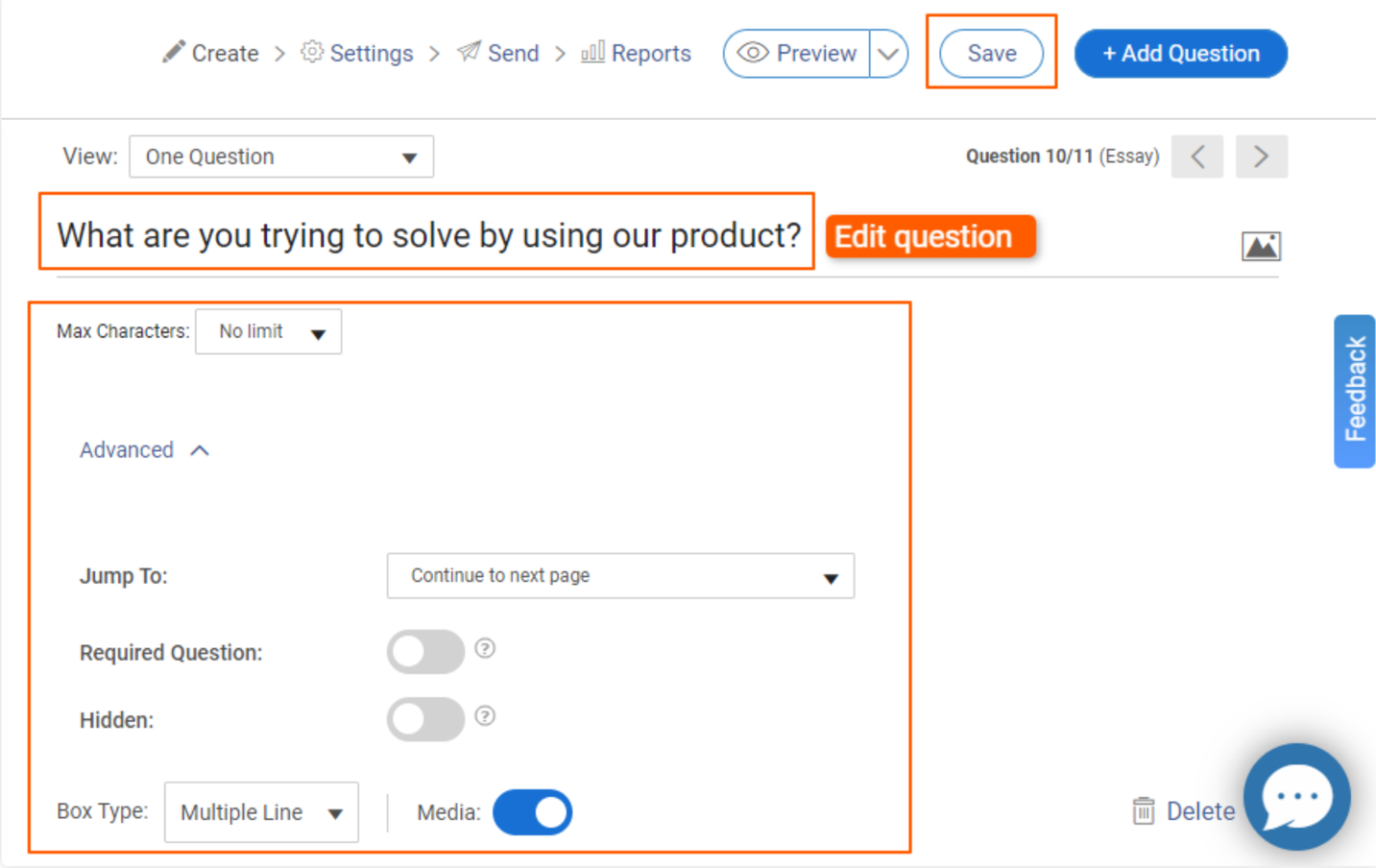
Step 3: Write and adjust settings
Type your question clearly. In Advanced Settings, you can:
- Set a minimum character limit to get more detailed replies
- Set a maximum limit if needed, but avoid cutting people off
Step 4: Choose response type
- Keep Alphanumeric for regular text responses (letters, numbers, symbols)
- Use Numeric only if you’re asking for numbers like age or quantity
Step 5: Final touches
If the question is important, make it mandatory. You can also add an image for context. When you’re done, click “Save.”
Examples of Qualitative Research Questions
Crafting effective survey questions is crucial for qualitative research. Ensuring clarity, avoiding leading questions, and maintaining a balanced mix of question types is paramount if you are looking to gather comprehensive and valuable qualitative data.
With well-designed website survey questions, you can delve deep into participants’ thoughts, emotions, and experiences, providing a solid foundation for insightful qualitative analysis.
Let’s explore some of the prime examples:
1. Open-Ended Questions (Exploratory)
- “Please describe your experience with our product/service in your own words.”
- “What are the main challenges you face in your daily work?”
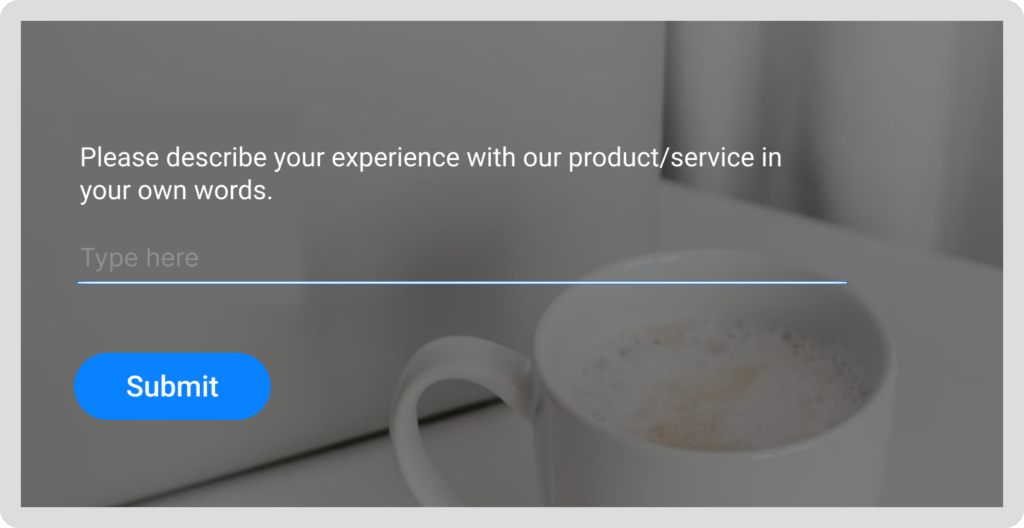
2. Multiple-Choice Questions (Categorization)
“Which age group do you belong to?”
- 18-25 years
- 26-35 years
- 36-45 years
- 46-55 years
- 56+ years
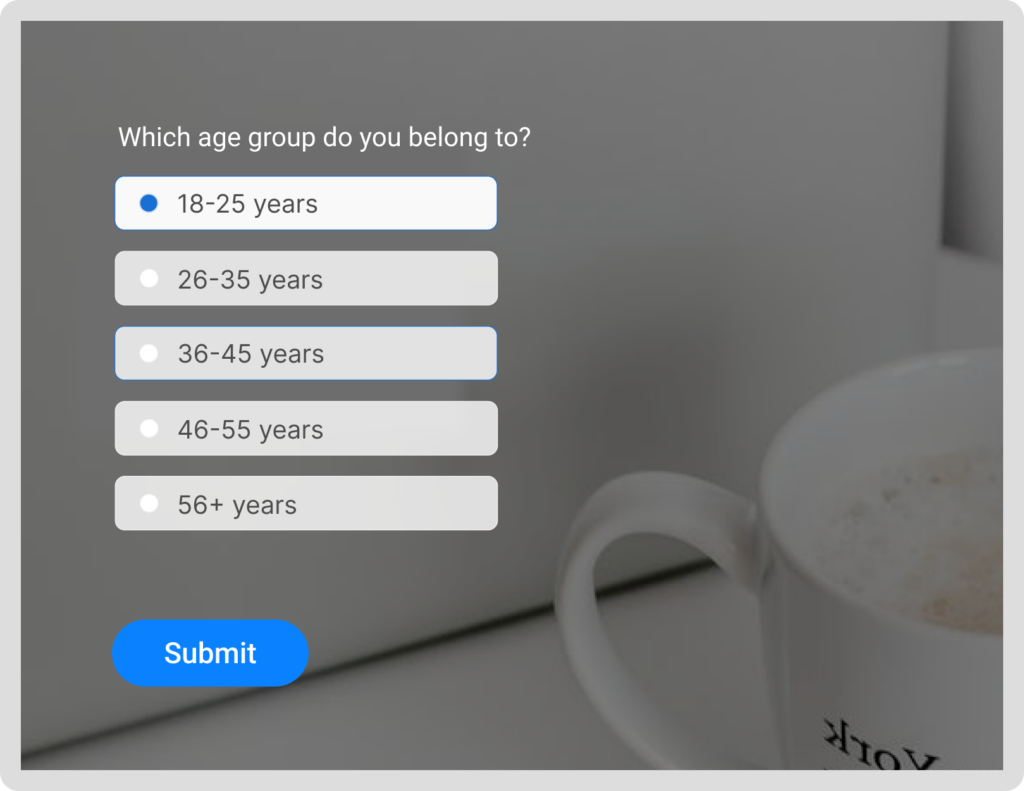
3. Likert Scale Questions (Rating/Opinion)
- “On a scale of 1 to 5, how satisfied are you with our customer support?”
1 (Not satisfied at all)
2 (Slightly satisfied)
3 (Moderately satisfied)
4 (Very satisfied)
5 (Extremely satisfied)
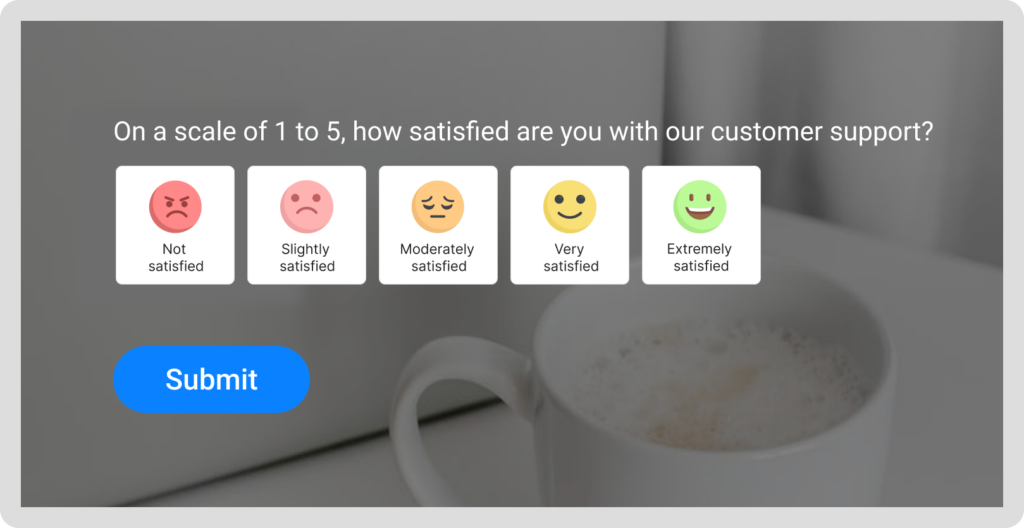
4. Ranking Questions (Preference)
“Rank the following factors in order of importance for choosing a smartphone:”
- Battery life
- Camera quality
- Processor speed
- Display resolution
5. Semantic Differential Questions (Contrast)
“How would you describe our website’s user interface?”
- Difficult _ Easy Unattractive Attractive
- Confusing ___ Clear
6. Picture Choice Questions (Visual Feedback)
“Which logo do you find more appealing for our brand?”
- Option A (Image)
- Option B (Image)
7. Demographic Questions (Participant Profiling)
“Which of the following best describes your occupation?”
- Student
- Professional
- Homemaker
- Retired
8. Dichotomous Questions (Yes/No)
“Have you ever purchased products from our online store?”
- Yes
- No

9. Follow-Up Probing Questions (In-depth Insight)
- “You mentioned facing challenges at work. Could you please elaborate on the specific challenges you encounter?”
10. Experience-Based Questions (Narrative)
- “Tell us about a memorable customer service experience you’ve had, whether positive or negative.”
FREE. All Features. FOREVER!
Try our Forever FREE account with all premium features!
When to Use Qualitative Research
Qualitative research is most effective when you’re trying to dive deep into the “why” behind human behaviors, attitudes, or emotions. Here’s when you should consider using it:
1. Exploring New Areas: If you’re entering a new area of study or your topic hasn’t been well researched, qualitative research is ideal. It allows you to generate new ideas and insights without predefined assumptions.
For instance, if you’re studying the emerging behavior of remote workers post-pandemic, qualitative research helps you explore how and why people feel a certain way about working from home.
2. Understanding Complex or Sensitive Issues: Qualitative research is perfect when you need to grasp the complexities of sensitive topics such as mental health, trauma, or societal issues. It gives participants the freedom to express themselves in their own words, offering rich, detailed insights.
For example, when investigating the impact of workplace stress, qualitative interviews can reveal personal stories that a simple survey might miss.
3. Gaining Deep Insights Into Specific Groups: If you need to understand the culture, beliefs, or daily routines of a specific community or subgroup, qualitative research offers in-depth understanding.
Whether you’re studying how teens use social media or how a certain demographic responds to healthcare practices, qualitative methods will give you that nuanced insight.
4. Developing Theories: When the goal is to develop new theories or models rather than test existing ones, qualitative research is key. It’s often used in the early stages of research to uncover new perspectives and inform future quantitative studies.
5. Exploring Experiences and Perceptions: When you need to explore personal experiences or perceptions in depth, qualitative research is ideal. For example, if you’re studying customer satisfaction with a new product, qualitative interviews can help you understand not just whether customers are happy but why they feel the way they do.
Advantages of Qualitative Research
Qualitative market research techniques offer a more comprehensive and complete picture of the subject than quantitative research, which focuses on specific and narrow areas. Other advantages of using qualitative research methods are:
- Explores the subject in-depth: Qualitative research is personal and offers a deep understanding of the respondent’s feelings, thoughts, and actions so that the researcher can perform an in-depth analysis of the subject.
- Promotes discussion: Qualitative research methods are open-ended in approach rather than rigorously following a predetermined set of questions. It adds context to the research rather than just numbers.
- More flexibility: The interviewer can study and ask questions on the subject they feel is pertinent or had not previously thought about during the discussions. Moreover, open-ended questions enable respondents to be free to share their thoughts, leading to more information.
- Capture trends as they change: Qualitative research can track how people’s feelings and attitudes change over time. Respondents’ opinions can change during the conversation, and qualitative research can show this.
Disadvantages of Qualitative Research
Despite the perks, qualitative data is not entirely devoid of flaws. Like most things, it, too, has its fair share of limitations, the prime among them being:
- Subjectivity: Qualitative data can be influenced by the researcher’s bias or interpretation, potentially affecting the objectivity of the findings. The absence of strict guidelines in qualitative research can lead to variations in data collection and analysis too.
- Time-consuming & resource-intensive: Conducting qualitative research can be a lengthy process, from data collection through transcription and analysis. It also often requires skilled researchers, making it more resource-intensive compared to some quantitative methods.
- Difficult to analyze: Analyzing qualitative data can be complex, as it involves coding, categorizing, and interpreting open-ended responses. This data category often does not lend itself well to traditional statistical tests, limiting the depth of statistical analysis as well.
- Non-replicable: Replicating qualitative studies can be challenging due to the unique context and interactions involved.
How Do You Analyze Qualitative Data?
Analyzing qualitative data involves systematically interpreting non-numerical information to identify patterns, themes, and insights. Here’s a practical guide to how to analyze qualitative data effectively:
1. Organize and Prepare Your Data
Before diving into analysis, ensure all your data is well-organized. Whether it’s transcripts from interviews, notes from observations, or text responses from surveys, get everything into a readable format. It’s often helpful to assign codes to each participant or data source for easier reference.

Practical Tip: If you have interviews, transcribe them. Use software like Otter.ai for quicker transcription, but always review and clean up the automated output to ensure accuracy.
2. Familiarize Yourself With the Data
Spend time reading through the data in its entirety at least once before beginning analysis. This step helps you get a sense of the overall content and identify initial patterns or interesting points. Take notes on any emerging themes, phrases, or contradictions you notice during this process.
Practical Tip: Highlighting or annotating key sections as you read can help make your analysis more efficient later.
3. Coding
Coding is the process of labeling sections of your data with tags or codes that identify key themes or concepts. Codes can be descriptive (e.g., “customer satisfaction”) or interpretive (e.g., “frustration with product features”). Go through the data line by line, assigning codes that represent the essence of what’s being said.

Practical Tip: Use software like NVivo, Atlas.ti, or even Excel to help organize and manage your codes. Create a coding schema that is consistent and reflects the categories you want to explore.
4. Categorize and Identify Themes
After coding, start grouping similar codes into broader categories or themes. These themes represent the larger patterns in your data, such as recurring problems, shared attitudes, or common experiences among participants. Themes can emerge both inductively (from the data itself) or deductively (based on pre-established theories or hypotheses).
Practical Tip: Look for relationships between codes and themes. For example, if several codes relate to “poor customer service,” this might lead to the broader theme of “service dissatisfaction.”
If you’re using ProProfs Survey Maker, you can export open-ended responses to Excel or view them directly in the analytics dashboard.
Use keyword filters to spot recurring themes, tag responses with custom labels, and group similar answers for easier analysis.
While the platform doesn’t offer automated thematic analysis, these built-in tools help you quickly organize feedback and identify common threads.
5. Look for Patterns and Relationships
Once you have your themes, look for patterns, relationships, or differences in the data. For example, do certain themes appear more frequently in specific groups of participants (e.g., men vs. women, younger vs. older)? Are there any outliers or contradictions in the data that need explaining?
Practical Tip: Use matrices or diagrams to map out relationships between different themes and variables. This can help visualize complex connections and make the patterns more apparent.
6. Interpret the Data
Interpretation is about understanding what the data means beyond the surface level. This involves asking deeper questions: Why are participants feeling this way? What factors might be influencing their perspectives? How do these findings relate to your research questions or objectives? Interpretation often involves contextualizing your findings within broader social, cultural, or theoretical frameworks.

Practical Tip: Use direct quotes from participants to illustrate your findings, but ensure you explain the significance of these quotes in your analysis.
7. Validate Your Findings
Ensuring the validity and reliability of your qualitative analysis is crucial. One way to do this is through triangulation—using multiple data sources or researchers to cross-check findings. You can also seek feedback from participants to verify if your interpretations resonate with their experiences (this is known as member checking).
Practical Tip: Have a colleague review your coding or themes to see if they identify similar patterns. This peer debriefing can help strengthen the validity of your analysis.
8. Draw Conclusions and Report Findings
Once you’ve interpreted the data, it’s time to draw conclusions and write up your findings. Be clear about what the data reveals regarding your research questions. In qualitative research, it’s also important to acknowledge the limitations of your findings—what your data cannot tell you, or where further research may be needed.
Practical Tip: In reporting, balance your presentation of data with your interpretations. Use illustrative examples from the data to support your claims, but avoid overgeneralizing beyond what the data can reasonably show.
FREE. All Features. FOREVER!
Try our Forever FREE account with all premium features!
What Is the Difference Between Qualitative and Quantitative Research?
The following table compares Qualitative and Quantitative Research:
| Aspect | Qualitative Research | Quantitative Research |
|---|---|---|
| Definition | Explores and provides insights into underlying reasons, opinions, and motivations. Focuses on subjective experiences and understanding complex phenomena. | Measures and quantifies data to explain patterns and relationships, focusing on objective, numerical data. |
| Purpose | To explore ideas, experiences, and understand the 'why' behind behaviors and attitudes. | To quantify data and generalize results from a larger sample to a population. |
| Nature of Data | Non-numerical, descriptive, and often subjective. Includes texts, interviews, observations, and multimedia. | Numerical, statistical data that is measurable and objective. |
| Data Collection Methods | In-depth interviews, focus groups, ethnography, case studies, open-ended questions, and participant observations. | Surveys with closed-ended questions, structured observations, experiments, and standardized tests. |
| Type of Data Analysis | Thematic analysis, content analysis, discourse analysis, grounded theory, phenomenology. | Statistical analysis, such as descriptive statistics, inferential statistics, and hypothesis testing. |
| Research Objective | To understand the meaning behind a phenomenon, explore contexts, and uncover trends or patterns. | To test hypotheses, assess relationships between variables, and predict outcomes using statistical tools. |
| Sample Size | Smaller, non-representative, and purposefully selected to gain deeper insights. Sample size often depends on data saturation (when no new information is emerging). | Larger, representative, and randomly selected to ensure generalizability. Sample size is often determined through statistical power analysis. |
| Data Output | Detailed narratives, rich descriptions, and non-statistical data that provide deep insights into a specific context or phenomenon. | Numerical outputs such as percentages, averages, and statistical significance, which can be generalized to the wider population. |
| Researcher’s Role | The researcher actively engages with participants, often as an observer or participant-observer, influencing the interpretation of the data. | The researcher is detached and objective, aiming to minimize bias and interference in the data collection process. |
| Approach to Reality | Assumes reality is subjective and constructed by participants’ experiences and perceptions. Multiple realities exist based on individual perspectives. | Assumes reality is objective and can be measured and quantified through observable phenomena. One single reality exists and can be explained through numbers. |
| Use Cases | Ideal for exploring new concepts, understanding social processes, and studying behaviors in context (e.g., cultural studies, psychology, marketing research). | Ideal for testing theories, identifying patterns, and confirming hypotheses (e.g., epidemiology, economics, market research). |
| Strengths | Provides deep, rich data that can lead to new insights and theories. Flexibility allows for the exploration of complex issues in detail. | Allows for the analysis of large amounts of data and provides a high level of accuracy. Data can be easily compared, generalized, and replicated. |
| Limitations | Time-consuming, often expensive, and findings can be difficult to generalize due to small sample sizes. Results may be subject to researcher bias. | May overlook the context and complexity of human experience by focusing only on numbers. Limited by pre-set questions and rigid data collection instruments. |
| Examples | A study exploring how patients feel about end-of-life care through in-depth interviews. A researcher spends months embedded in a community to understand their daily practices. | A survey conducted with 5000 respondents to measure the correlation between exercise frequency and heart disease. An experiment testing the effectiveness of a new drug on a large group of participants. |
Additional Insights:
- Qualitative Research is often used in the early stages of research to generate ideas, understand the context, and develop hypotheses, while Quantitative Research is typically used to test hypotheses and validate theories using measurable data.
- Qualitative Data Analysis involves identifying patterns and themes that emerge from the data, while Quantitative Data Analysis involves statistical calculations to draw conclusions based on numerical evidence.
- In Qualitative Research, the researcher plays an active role and often becomes part of the data collection process, whereas, in Quantitative Research, the researcher maintains a detached and objective stance to avoid influencing the outcomes.
Obtain In-Depth Data Using Qualitative Research
Qualitative research serves as a vital tool in understanding the rich, complex, and nuanced aspects of human behavior, thoughts, and experiences.
Unlike quantitative research, which focuses on measurable data and statistics, qualitative research delves into the why behind actions and attitudes, offering deep insights that numbers alone cannot provide.
Ultimately, qualitative research equips researchers with a deeper understanding of the human experience, enabling them to uncover insights that can drive meaningful changes in various fields—from psychology and sociology to business and marketing.
Whether you are studying customer behavior, healthcare experiences, or societal trends, qualitative research offers a unique lens through which you can explore and make sense of the world around you.
Hope this blog has helped you understand the topic in-depth. Happy surveying!
 Tips
Tips
We’d love to hear your tips & suggestions on this article!
FREE. All Features. FOREVER!
Try our Forever FREE account with all premium features!



 We'd love your feedback!
We'd love your feedback! Thanks for your feedback!
Thanks for your feedback!







